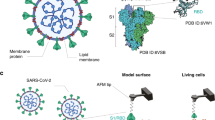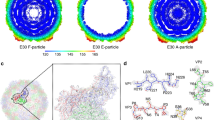Abstract
Nipah and Hendra viruses are emergent paramyxoviruses, causing disease characterized by rapid onset and high mortality rates, resulting in their classification as Biosafety Level 4 pathogens. Their attachment glycoproteins are essential for the recognition of the cell-surface receptors ephrin-B2 (EFNB2) and ephrin-B3 (EFNB3). Here we report crystal structures of both Nipah and Hendra attachment glycoproteins in complex with human EFNB2. In contrast to previously solved paramyxovirus attachment complexes, which are mediated by sialic acid interactions, the Nipah and Hendra complexes are maintained by an extensive protein-protein interface, including a crucial phenylalanine side chain on EFNB2 that fits snugly into a hydrophobic pocket on the viral protein. By analogy with the development of antivirals against sialic acid binding viruses, these results provide a structural template to target antiviral inhibition of protein-protein interactions.
This is a preview of subscription content, access via your institution
Access options
Subscribe to this journal
Receive 12 print issues and online access
$189.00 per year
only $15.75 per issue
Buy this article
- Purchase on Springer Link
- Instant access to full article PDF
Prices may be subject to local taxes which are calculated during checkout




Similar content being viewed by others
References
Eaton, B.T., Broder, C.C., Middleton, D. & Wang, L.F. Hendra and Nipah viruses: different and dangerous. Nat. Rev. Microbiol. 4, 23–35 (2006).
Parashar, U.D. et al. Case-control study of risk factors for human infection with a new zoonotic paramyxovirus, Nipah virus, during a 1998–1999 outbreak of severe encephalitis in Malaysia. J. Infect. Dis. 181, 1755–1759 (2000).
Selvey, L.A. et al. Infection of humans and horses by a newly described morbillivirus. Med. J. Aust. 162, 642–645 (1995).
Murray, K. et al. A morbillivirus that caused fatal disease in horses and humans. Science 268, 94–97 (1995).
Hsu, V.P. et al. Nipah virus encephalitis reemergence, Bangladesh. Emerg. Infect. Dis. 10, 2082–2087 (2004).
Mohd Nor, M.N., Gan, C.H. & Ong, B.L. Nipah virus infection of pigs in peninsular Malaysia. Rev. Sci. Tech. 19, 160–165 (2000).
Guillaume, V. et al. Nipah virus: vaccination and passive protection studies in a hamster model. J. Virol. 78, 834–840 (2004).
Guillaume, V. et al. Antibody prophylaxis and therapy against Nipah virus infection in hamsters. J. Virol. 80, 1972–1978 (2006).
Bossart, K.N. & Broder, C.C. Developments towards effective treatments for Nipah and Hendra virus infection. Expert Rev. Anti Infect. Ther. 4, 43–55 (2006).
Negrete, O.A. et al. EphrinB2 is the entry receptor for Nipah virus, an emergent deadly paramyxovirus. Nature 436, 401–405 (2005).
Negrete, O.A. et al. Two key residues in ephrinB3 are critical for its use as an alternative receptor for Nipah virus. PLoS Pathog. 2, e7 (2006).
Bonaparte, M.I. et al. Ephrin-B2 ligand is a functional receptor for Hendra virus and Nipah virus. Proc. Natl. Acad. Sci. USA 102, 10652–10657 (2005).
Wilkinson, D.G. Multiple roles of EPH receptors and ephrins in neural development. Nat. Rev. Neurosci. 2, 155–164 (2001).
Himanen, J.P. et al. Crystal structure of an Eph receptor-ephrin complex. Nature 414, 933–938 (2001).
Himanen, J.P. et al. Repelling class discrimination: ephrin-A5 binds to and activates EphB2 receptor signaling. Nat. Neurosci. 7, 501–509 (2004).
Chrencik, J.E. et al. Structure and thermodynamic characterization of the EphB4/Ephrin-B2 antagonist peptide complex reveals the determinants for receptor specificity. Structure 14, 321–330 (2006).
Chrencik, J.E. et al. Structural and biophysical characterization of the EphB4-ephrinB2 protein-protein interaction and receptor specificity. J. Biol. Chem. 281, 28185–28192 (2006).
Chrencik, J.E. et al. Three dimensional structure of the EPHB2 receptor in complex with an antagonistic peptide reveals a novel mode of inhibition. J. Biol. Chem. 282, 36505–36513 (2007).
Lawrence, M.C. et al. Structure of the haemagglutinin-neuraminidase from human parainfluenza virus type III. J. Mol. Biol. 335, 1343–1357 (2004).
Crennell, S., Takimoto, T., Portner, A. & Taylor, G. Crystal structure of the multifunctional paramyxovirus hemagglutinin-neuraminidase. Nat. Struct. Biol. 7, 1068–1074 (2000).
Yuan, P. et al. Structural studies of the parainfluenza virus 5 hemagglutinin-neuraminidase tetramer in complex with its receptor, sialyllactose. Structure 13, 803–815 (2005).
Bishop, K.A. et al. Identification of Hendra virus g glycoprotein residues that are critical for receptor binding. J. Virol. 81, 5893–5901 (2007).
Guillaume, V. et al. Evidence of a potential receptor-binding site on the Nipah virus G protein (NiV-G): identification of globular head residues with a role in fusion promotion and their localization on an NiV-G structural model. J. Virol. 80, 7546–7554 (2006).
Negrete, O.A., Chu, D., Aguilar, H.C. & Lee, B. Single amino acid changes in the Nipah and Hendra virus attachment glycoprotein distinguishes ephrinB2 from ephrinB3 usage. J. Virol. 81, 10804–10814 (2007).
Aricescu, A.R., Lu, W. & Jones, E.Y. A time- and cost-efficient system for high-level protein production in mammalian cells. Acta Crystallogr. D Biol. Crystallogr. 62, 1243–1250 (2006).
Chang, V.T. et al. Glycoprotein structural genomics: solving the glycosylation problem. Structure 15, 267–273 (2007).
Hashiguchi, T. et al. Crystal structure of measles virus hemagglutinin provides insight into effective vaccines. Proc. Natl. Acad. Sci. USA 104, 19535–19540 (2007).
Colf, L.A., Juo, Z.S. & Garcia, K.C. Structure of the measles virus hemagglutinin. Nat. Struct. Mol. Biol. 14, 1227–1228 (2007).
Santiago, C., Bjorling, E., Stehle, T. & Casasnovas, J.M. Distinct kinetics for binding of the CD46 and SLAM receptors to overlapping sites in the measles virus hemagglutinin protein. J. Biol. Chem. 277, 32294–32301 (2002).
Toth, J. et al. Crystal structure of an ephrin ectodomain. Dev. Cell 1, 83–92 (2001).
Stuart, D.I., Levine, M., Muirhead, H. & Stammers, D.K. Crystal structure of cat muscle pyruvate kinase at a resolution of 2.6. J. Mol. Biol. 134, 109–142 (1979).
Lawrence, M.C. & Colman, P.M. Shape complementarity at protein/protein interfaces. J. Mol. Biol. 234, 946–950 (1993).
Bossart, K.N. et al. Functional studies of host-specific ephrin-B ligands as Henipavirus receptors. Virology 372, 357–371 (2008).
Pabbisetty, K.B. et al. Kinetic analysis of the binding of monomeric and dimeric ephrins to Eph receptors: correlation to function in a growth cone collapse assay. Protein Sci. 16, 355–361 (2007).
Li, W. et al. Identification of GS 4104 as an orally bioavailable prodrug of the influenza virus neuraminidase inhibitor GS 4071. Antimicrob. Agents Chemother. 42, 647–653 (1998).
Altamirano, M.M. et al. Ligand-independent assembly of recombinant human CD1 by using oxidative refolding chromatography. Proc. Natl. Acad. Sci. USA 98, 3288–3293 (2001).
Walter, T.S. et al. A procedure for setting up high-throughput nanolitre crystallization experiments. Crystallization workflow for initial screening, automated storage, imaging and optimization. Acta Crystallogr. D Biol. Crystallogr. 61, 651–657 (2005).
Otwinowski, Z. & Minor, W. Processing of X-ray diffraction data collected in oscillation mode. Methods Enzymol. 276, 307–326 (1997).
Kabsch, W. Automatic processing of rotation diffraction data from crystals of initially unknown symmetry and cell constants. J. Appl. Crystallogr. 26, 795–800 (1993).
McCoy, A.J., Grosse-Kunstleve, R.W., Storoni, L.C. & Read, R.J. Likelihood-enhanced fast translation functions. Acta Crystallogr. D Biol. Crystallogr. 61, 458–464 (2005).
Perrakis, A., Harkiolaki, M., Wilson, K.S. & Lamzin, V.S. ARP/wARP and molecular replacement. Acta Crystallogr. D Biol. Crystallogr. 57, 1445–1450 (2001).
Collaborative Computational Project, Number 4. The CCP4 suite: programs for protein crystallography. Acta Crystallogr. D Biol. Crystallogr. 50, 760–763 (1994).
Brunger, A.T. et al. Crystallography & NMR system: a new software suite for macromolecular structure determination. Acta Crystallogr. D Biol. Crystallogr. 54, 905–921 (1998).
Murshudov, G.N., Vagin, A.A. & Dodson, E.J. Refinement of macromolecular structures by the maximum-likelihood method. Acta Crystallogr. D Biol. Crystallogr. 53, 240–255 (1997).
Adams, P.D. et al. PHENIX: building new software for automated crystallographic structure determination. Acta Crystallogr. D Biol. Crystallogr. 58, 1948–1954 (2002).
Emsley, P. & Cowtan, K. Coot: model-building tools for molecular graphics. Acta Crystallogr. D Biol. Crystallogr. 60, 2126–2132 (2004).
Hooft, R.W., Vriend, G., Sander, C. & Abola, E.E. Errors in protein structures. Nature 381, 272 (1996).
Laskowski, R.A., MacArthur, M.W., Moss, D.S. & Thornton, J.M. PROCHECK: a program to check the stereochemical quality of protein structures. J. Appl. Crystallogr. 26, 283–291 (1993).
Aricescu, A.R. et al. Molecular analysis of receptor protein tyrosine phosphatase μ-mediated cell adhesion. EMBO J. 25, 701–712 (2006).
Wallace, A.C., Laskowski, R.A. & Thornton, J.M. LIGPLOT: a program to generate schematic diagrams of protein-ligand interactions. Protein Eng. 8, 127–134 (1995).
Corpet, F. Multiple sequence alignment with hierarchical clustering. Nucleic Acids Res. 16, 10881–10890 (1988).
Gouet, P., Courcelle, E., Stuart, D.I. & Metoz, F. ESPript: analysis of multiple sequence alignments in PostScript. Bioinformatics 15, 305–308 (1999).
Acknowledgements
We are grateful for the help of W. Lu in tissue culture, K. Harlos for data collection, C. O'Callaghan for discussions and the staff of beamlines ID14.2 and ID23.1 at the European Synchotron Radiation Facility for assistance. This work was funded by the Wellcome Trust, Medical Research Council, Royal Society, Cancer Research UK and Spine2 Complexes (FP6-RTD-031220).
Author information
Authors and Affiliations
Contributions
T.A.B., A.R.A., J.M.G., E.Y.J. and D.I.S. contributed to the design of the project and preparation of the manuscript; T.A.B. was responsible for Kd determination. T.A.B. and A.R.A. were responsible for cloning and construct design; T.A.B. expressed, purified and crystallized the HNV-G complexes; T.A.B., J.M.G. and D.I.S. contributed to X-ray data collection and solving the structure of NiV-G−EFNB2 and HeV-G−EFNB2; T.A.B. and R.J.C.G. performed AUC analysis of NiV-G.
Corresponding author
Supplementary information
Supplementary Text and Figures
Supplementary Figures 1–8 and Supplementary Table 1 (PDF 1383 kb)
Rights and permissions
About this article
Cite this article
Bowden, T., Aricescu, A., Gilbert, R. et al. Structural basis of Nipah and Hendra virus attachment to their cell-surface receptor ephrin-B2. Nat Struct Mol Biol 15, 567–572 (2008). https://doi.org/10.1038/nsmb.1435
Received:
Accepted:
Published:
Issue Date:
DOI: https://doi.org/10.1038/nsmb.1435
This article is cited by
-
Potent human neutralizing antibodies against Nipah virus derived from two ancestral antibody heavy chains
Nature Communications (2024)
-
Are we ready to fight the Nipah virus pandemic? An overview of drug targets, current medications, and potential leads
Structural Chemistry (2023)
-
Evaluation of the interaction between potent small molecules against the Nipah virus Glycoprotein in Malaysia and Bangladesh strains, accompanied by the human Ephrin-B2 and Ephrin-B3 receptors; a simulation approach
Molecular Diversity (2023)
-
Molecular Pathogenesis of Nipah Virus
Applied Biochemistry and Biotechnology (2023)
-
Glycoprotein attachment with host cell surface receptor ephrin B2 and B3 in mediating entry of nipah and hendra virus: a computational investigation
Journal of Chemical Sciences (2022)



